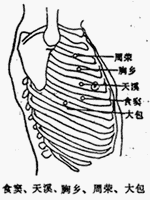bubble_chart Etymology "Shi" (食), food; "dou" (竇), pore, refers to this acupoint. This point mainly treats disorders related to diet and digestion, hence its name.
bubble_chart Location
On the lateral side of chest, 6 cun lateral to the anterior midline, in the depression of the 5th intercostal space. 2 cun lateral to
Rugen (ST18), level with
Zhongting (CV16).
- Zhenjiu Jiayi Jing: "1.6 cun below Tianxi (SP18), in the depression";
- Bian Que Xinshu: "6 cun below Zhongfu (LU1)";
- Zhenfang Liuji: "6 cun lateral to conception vessel on both sides";
- Xunjing Kaoxue Bian: "Level with Zhongting (CV16)".
bubble_chart Anatomy
- Muscles: serratus anterior, internal and external intercostal muscles in deep layer.
- Nerve: lateral cutaneous branch of the fifth intercostal nerve.
- Vessel: thoracic and abdominal wall veins.
bubble_chart Manipulation
Insert horizontally along the intercostal space 0.3 to 0.5 cun. Moxibustion with moxa cone 3 to 5 times, moxibustion with moxa stick for 10 to 15 minutes.
bubble_chart Efficacy
Benefit chest and diaphragm, regulate spleen and stomach.
- Classical: hypochondriac pain, pain connecting both flanks and heart, fullness and distension in chest and hypochondrium, rumbling sounds in diaphragm, frequent water gurgling sounds, severe damage to spleen qi, edema and tympanites, urinary obstruction, postpartum abdominal distension and edema, regurgitation, vomiting immediately after eating, taiyin disease caused by cold injury.
- Modern: asthma.
bubble_chart Combinations
- Fullness and pain in chest and hypochondrium: Shidou (SP17), Geshu (BL17), Sanyangluo (TE8).
bubble_chart Other Related Items
